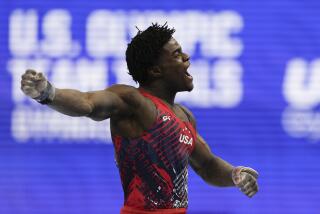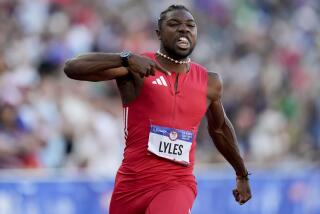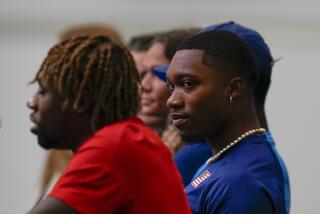Tough Regimen for Olympians
- Share via
With the spotlight on the Olympics--and the equestrian events in Seoul concluding Sunday--many riders have caught the fever and hope to “ride for America” someday.
Few, however, are familiar with the lengthy selection process involved in choosing Olympic equestrians. If you have caught “Olympics fever,” consider what the road to Seoul involved.
Jonathan Burton, a judge at the 1984 Olympic equestrian events, knows that road well. The retired Army general has been on the selection committee for the U.S. equestrian team’s three-day event squad for numerous Olympic, Pan American and World Championship competitions. He is in Seoul as chef d’equipe (manager) of the USET’s three-day event squad.
Officiating at a dressage show at the Orange County Fairgrounds in July before leaving for Seoul, Burton watched Olympic hopefuls. It was a familiar scene for Burton, who is often asked by riders for a “leg up” on how to be selected for what is known in riding circles simply as “the team.”
One letter Burton received when he was executive vice president of the U.S. equestrian team read:
“I am only 12 years old, but I want to be on the team more than anything in the world. I know I could be good because I would really put my heart into it. . . . I would appreciate it if you would write back and help me be in it.”
Burton wrote back. He says he encourages all interested young riders because “you never know when there might be another Bruce Davidson out there.” Davidson, who was twice world champion in three-day eventing, earned a spot on the USET through the same channels as Tad Coffin--the youngest equestrian Olympic gold medalist at age 21 in the 1976 Games.
The selection process for the USET begins officially for a rider at age 16, when the rider may enter the official screening trials, (which are designated and published in advance in equestrian magazines). The year after the Olympics, USET coaches and selectors observe hundreds of riders at these trials.
Several groups of top competitors are invited to come to team headquarters in South Hamilton, Mass., or Gladstone, N.J., for training sessions with team coaches. USET clinics are sometimes held in California for West Coast riders.
The training sessions involve at least a 12-hour day, with riders required to feed and care for their own horses. The day begins at 6 a.m., with riding sessions continually from 8:30 a.m. to 4:30 p.m. After that, riders meticulously clean their tack and groom their horses. At 7:30 p.m., the riders gather to watch videotapes, with critiques by the coach.
Riders who make a favorable impression at the training sessions are invited to return for more training over the next several years. The best enter the official selection trials for upcoming Olympics, Pan American Games or World Championships.
A rider may borrow a mount to compete in the initial trials.
Burton says, “If you have a reputation, the team will provide horses for you.”
How does a young rider get a reputation? By competing in the screening trials and turning in consistent performances that catch the eye of USET “talent scouts” who watch many of the trials. The best way to make a favorable impression is to end up in the winner’s circle, which can be difficult to do if you don’t have an accomplished horse. But Burton says a rider who can “carry” an unmade horse over a course still demonstrates talent.
In making team selections, he says the “age-old question” is what percentage is the horse and what percentage is the rider. The trick for the selection panel is to find the right combination of both: Tad Coffin and Bally Cor, Karen Stives and The Saint, and maybe next, the kid down the street and Old Paint.
For more information on the selection process, write the U.S. Equestrian Team at its respective headquarters: Three-day event team--292 Bridge St., South Hamilton, MA 01982; dressage and show-jumping teams--Gladstone, N.J. 07934.
More to Read
Go beyond the scoreboard
Get the latest on L.A.'s teams in the daily Sports Report newsletter.
You may occasionally receive promotional content from the Los Angeles Times.






